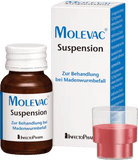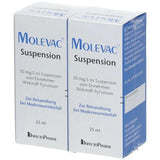MOLEVAC suspension, Against pinworms
50 mg/5 ml oral suspension
Active substance: pyrvinium
What Molevac is and what it is used for
Molevac is a drug used to treat pinworm infestation (oxyuriasis). Molevac can be used in children from 1 year of age, adolescents and adults. The active ingredient pyrvinium contained in Molevac is particularly effective against pinworms (oxyures). The worm-killing effect is based on a disruption in the metabolism of pinworms by Molevac.
Note: Molevac contains sucrose (sugar) and sodium compounds.
For the treatment of pinworm infestation.
active Against pinworms, MOLEVAC suspension ingredients
- 75.25 mg Pyrvinium hemiembonate
ingredients
- Trisodium phosphate-12 water
- 0.2 mg benzyl alcohol
- cherry flavor
- 5 mg benzoic acid
- Saccharin sodium-2 water
- Sodium hydroxide for pH adjustment
- Hydrochloric acid for pH adjustment
- water, purified
- 1150 mg sucrose
- methyl cellulose
- 662 mg propylene glycol
- Poloxamer 188
- sorbitan laurat
Against pinworms, MOLEVAC suspension Indication :
- This preparation is used to treat pinworm infestation (oxyuriasis). It can be used in children from 1 year, adolescents and adults.
- The contained active ingredient pyrvinium is especially effective against pinworms (oxyurae). The worm-killing effect is based on a disturbance in the metabolism of the pinworms.
Dosage Against pinworms, MOLEVAC suspension:
- Always take this medicine exactly as described or as your doctor or pharmacist has told you. Check with your doctor or pharmacist if you are not sure.
-
dosage
- The preparation is usually administered as a single dose.
-
Unless otherwise prescribed by the doctor, the usual dose is:
- Children from 1 year, adolescents and adults receive 5 ml (equivalent to 50 mg pyrvinium) per 10 kg body weight. The maximum dose for children, adolescents and adults (also with a body weight of more than 80 kg) is 40 ml (equivalent to 400 mg pyrvinium), see dosage table.
- If the effect is insufficient, the dose should not be increased, but the treatment should be repeated.
-
dosage table
-
children or young people
-
Approximate age (years): 1 - 3
- Body weight approx. (kg): 10 - 14
- Amount of drug (single dose) in ml: 5 - 7.5
-
Approximate age (years): 4 - 5
- Body weight approx. (kg): 15 - 19
- Amount of drug (single dose) in ml: 7.5 - 10
-
Approximate age (years): 6 - 9
- Body weight approx. (kg): 20 - 29
- Amount of drug (single dose) in ml: 10 - 15
-
Approximate age (years): 10 - 12
- Body weight approx. (kg): 30 - 39
- Amount of drug (single dose) in ml: 15 - 20
-
Age approx. (years): 13 - 14
- Body weight approx. (kg): 40 - 49
- Amount of drug (single dose) in ml: 20 - 25
-
Approximate age (years): 15 - 16
- Body weight approx. (kg): 50 - 59
- Amount of drug (single dose) in ml: 25 - 30
-
Approximate age (years): 1 - 3
-
Adult
-
Body weight approx. (kg): 60 - 69
- Amount of drug (single dose) in ml: 30 - 35
-
Body weight approx. (kg): 70 - 79
- Amount of drug (single dose) in ml: 35 - 40
-
Body weight approx. (kg): 80 (or more)
- Amount of drug (single dose) in ml: 40
-
Body weight approx. (kg): 60 - 69
-
children or young people
-
Use in children and adolescents
- The dosage for children from 1 year and adolescents can be found in the dosage table.
-
pregnant women
- When used during pregnancy, the dosage should be based on body weight before pregnancy.
-
Patients with impaired renal function
- The preparation must not be used in patients with impaired kidney function.
-
Patients with impaired liver function
- The preparation must not be used in patients with liver damage.
-
Elderly patients (over 65 years)
- If there is no impairment of the liver or kidney function, there are no special features to be considered.
-
duration of use
- Repeat the treatment in the same way after 2 to 4 weeks.
-
If you take more than you should
- an increase in the undesirable effects may occur. If signs of poisoning appear after ingestion, please consult a doctor immediately. He can arrange gastric lavage or the intake of medicinal charcoal.
-
If you forget to take a dose
- you can easily take the missing amount on the same day. In any case, you should take the stated total amount of the preparation.
- If you have any further questions on the use of this medicine, ask your doctor or pharmacist.
way :
- The preparation can be taken with a meal or on an empty stomach. If you need to take a larger amount of suspension, it is best to divide it into three portions: before, during and after the meal.
- In children, the suspension can be diluted with water or other liquids (fruit juice).
- The suspension should be shaken before use.
Side effects :
- Like all medicines, this medicine can cause side effects, although not everybody gets them.
-
The evaluation of side effects is based on the following frequency information:
- Very common: affects more than 1 in 10 people
- Common: affects 1 to 10 users in 100
- Uncommon: affects 1 to 10 users in 1,000
- Rare: affects 1 to 10 users in 10,000
- Very rare: affects less than 1 in 10,000 people
-
Diseases of the nervous system
- Uncommon: Headache
- Very rare: convulsions
-
Diseases of the ear and labyrinth
- Very rare: dizziness
-
Respiratory, thoracic and mediastinal disorders
- Very rare: transient internal swelling of the larynx (larynx oedema)
-
Diseases of the gastrointestinal tract
- Common: abdominal pain, nausea, vomiting
- Uncommon: diarrhea
- Rare: stomach cramps, flatulence, constipation
- Very rare: inflammation of the oral mucosa (stomatitis)
-
Skin and subcutaneous tissue disorders
- Very rare: allergic skin symptoms with and without itching, e.g. B. nettle rash with blisters and wheals (urticaria), sensitivity to light, skin rashes (rash), skin bleeding (purpura) and swelling of the skin and mucous membranes (angioedema)
- If you get any side effects, talk to your doctor or pharmacist. This also applies to side effects that are not specified.
Interactions :
-
Taking with other medicines
- Tell your doctor or pharmacist if you are taking/using, have recently taken/used or might take/use any other medicines.
- So far, no interactions with other drugs have been observed.
Contraindications :
-
The drug must not be taken
- if you are allergic to the active substance pyrvinium or any of the other ingredients of this medicine
- in liver damage
- in inflammatory bowel disease
- in renal dysfunction
Pregnancy and lactation :
- If you are pregnant or breast-feeding, think you may be pregnant or are planning to have a baby, ask your doctor or pharmacist for advice before taking this medicine.
-
pregnancy
- During pregnancy, you may only take the medicine if this is absolutely necessary, taking into account the risk for mother and child, e.g. B. because other active ingredients may not be taken.
- When used during pregnancy, the amount of medication should be based on the body weight before pregnancy.
-
lactation
- For safety reasons, breastfeeding mothers should pump and discard the milk during use.
-
women of childbearing age
- Women of childbearing potential should use effective contraception during treatment as the potential risk of using the drug during pregnancy is unknown.
Patient Notes :
-
Warnings and Precautions
- Please talk to your doctor or pharmacist before taking this medicine.
- This preparation stains the stool bright red. This has no disease value, but only indicates that the active ingredient has passed through the gastrointestinal tract properly.
- The active substance, pyrvinium, can cause discoloration of textiles, for example through vomiting or reddening of the stool. This discolouration cannot be washed out.
- In the case of a worm infestation, family members or other close contacts are often affected. Ask your doctor or pharmacist whether treatment should also be carried out on these contacts. Also pay attention to personal hygiene and thorough cleaning of living areas (home, workplace) and clothing.
-
Children
- The safety and effectiveness of the drug in children under 1 year have not yet been proven. The preparation is therefore not suitable for this age group.
-
Ability to drive and use machines
- There are no special precautions required.




